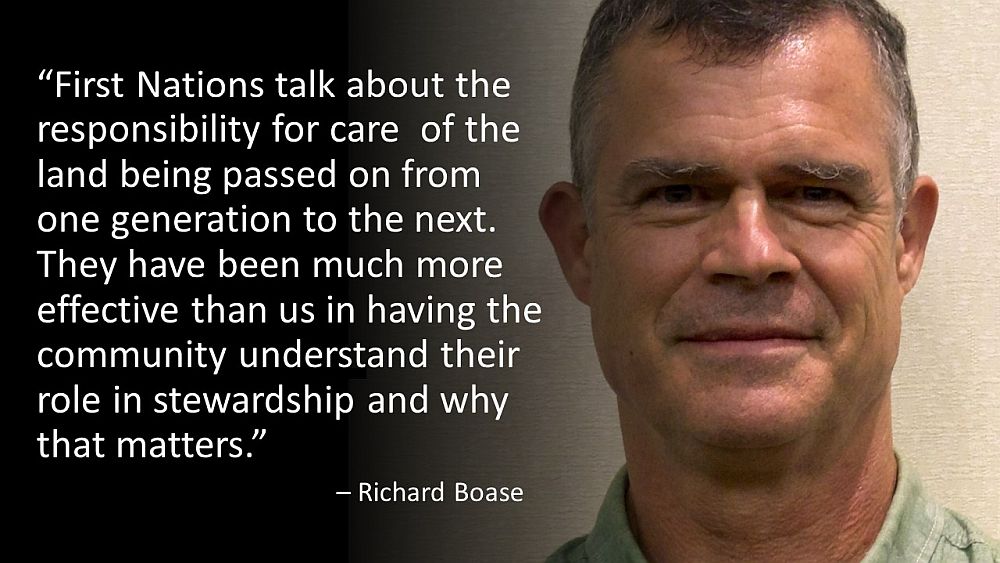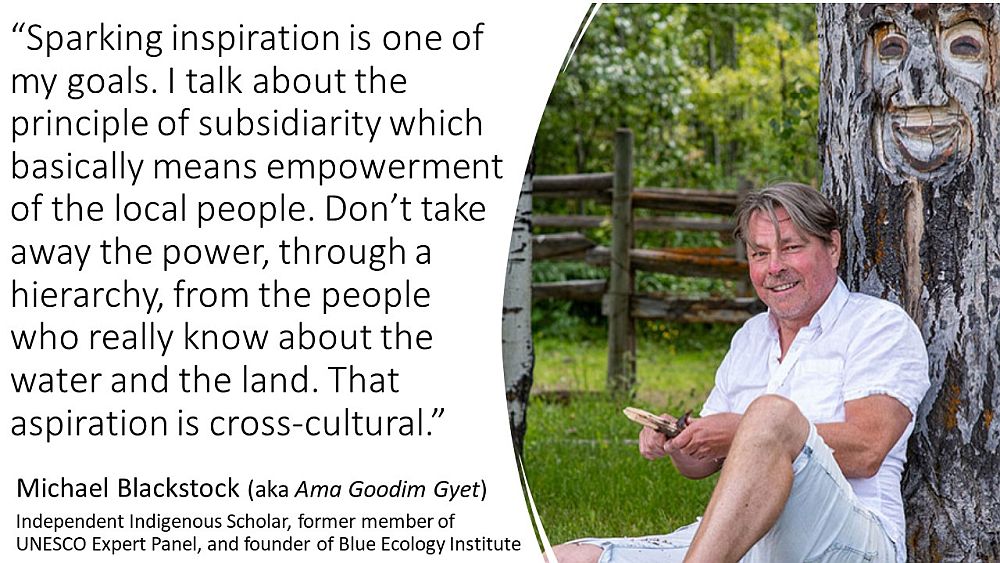What does “water reconciliation” look like?

Note to Reader:
Waterbucket eNews celebrates the leadership of individuals and organizations who are guided by the Living Water Smart vision. Storylines accommodate a range of reader attention spans. Read the headline and move on, or take the time to delve deeper – it is your choice! Downloadable versions are available at Living Water Smart in British Columbia: The Series.

“What I am learning from Indigenous people is how to effectively communicate the science of stewardship. Oral histories are living histories. They are not just about the past. They are current.”
Paul Chapman, Chair of the Watershed Moments Symposia Series & Blue Ecology Seminar Series
We have landed at the crux of two of the most important issues facing Canadians – relationships with First Nations and relationships with water – in an era when we must also adapt to a changing climate.
Communities have a once in a generation opportunity to get our relationships with both right, and then start back down the river of time – this time together. To move this bold idea forward, the Watershed Moments Team is showcasing the Blue Ecology vision for interweaving Western science and Indigenous knowledge through a symposia and seminar series.
Blue Ecology 101
Most recently, the engaging and dynamic team of Michael Blackstock, Brian Carruthers and Richard Boase seeded the idea that hope lies within the sphere of local government, whether that be non-Indigenous or Indigenous. That is the scale where actions do matter.
Michael Blackstock, independent Indigenous Scholar, is the founder of the Blue Ecology Institute. Brian Carruthers is former CAO of the Cowichan Valley Regional District. Richard Boase is with the District of North Vancouver.
For those readers who would have liked to join the live broadcast of the Blue Ecology Virtual Seminar on February 23rd, despair not! You can watch the replay at your convenience on YouTube.
In the weeks ahead, the Watershed Moment media technical team will transform the video of “Richard, Michael and Brian in conversation” into documentary quality for subsequent broadcast on cable TV. In the meantime, click on the image below and watch what you missed.
EDITOR’S PERSPECTIVE / STORY BEHIND THE STORY
The Watershed Moments message is compelling: Blue Ecology, a water-first approach to interweaving Indigenous and Western perspectives, is the pathway to “water reconciliation” in a changing climate.
Did Richard Boase, Michael Blackstock and Brian Carruthers light a spark with their knowledge and enthusiasm and leave the seminar audience with hope? Time will tell.
We learn through stories
To set the stage for 3-way interaction with Michael and Brian, moderator Richard shared a story with the audience about his epiphany while waiting for a group of engineering students to join him for a walkabout along Lynn Creek in North Vancouver.
As fate would have it, a Coast Salish elder chanced to show up just as Richard was contemplating what wisdom he would share with the students. Richard struck up a conversation as the elder was cutting boughs off the cedar tree where they were both standing. Richard asked why are you cutting those boughs. The elder replied:

An illustration of what thinking differently would look like for a stream
In that moment, Richard had an Aha realization. “For 30 years, I have used only Western science in my efforts to make changes in water resources. For the most part, I have not been successful. I asked the elder, what can I do differently?”
“By viewing everything around us in the natural world as having spirit, and having a personality and a purpose in how it relates to the people who live on the land, you are starting and charting on the right path, the elder explained.”
“It was an amazing story. Something amazing happened to me. When I met up with the engineering students, I passed on the words of wisdom from the elder. Imagine the water discharging from a storm sewer pipe into Lynn Creek, I said. In so many situations, it is a cause of degradation.”
“But it can be appreciated as a source of life. What if we think and design differently? What if that nuisance drainage flowed through a wetlands complex? If we give water even the smallest chance of creating life in the surrounding environment, it will.”
“It is the ability of water to create life that makes it spiritual. And that is why young engineers must think differently when given a task that relates to the handling of water. One of the failures of Western science, I believe, is its inability to create the kind of change that we know is possible.”
“And why is that? The explanation is that everything that students learn is in a textbook. They read it, they memorize, they pass an exam, and they move on. But if young people were taught, by their parents and grandparents, from the moment that they can understand, that water has a spiritual dimension, it would become a way of life.”
“That is what we can learn from Indigenous peoples. And that is where Michael Blackstock’s concept of interweaving comes into play to find the right balance,” concluded Richard Boase.


About the Partnership for Water Sustainability in BC
Technical knowledge alone is not enough to resolve water challenges facing BC. Making things happen in the real world requires an appreciation and understanding of human behaviour, combined with a knowledge of how decisions are made. It takes a career to figure this out.
The Partnership has a primary goal, to build bridges of understanding and pass the baton from the past to the present and future. To achieve the goal, the Partnership is growing a network in the local government setting. This network embraces collaborative leadership and inter-generational collaboration.
TO LEARN MORE, VISIT: https://waterbucket.ca/about-us/

